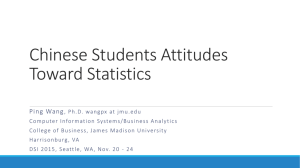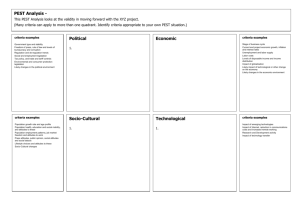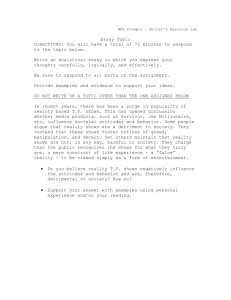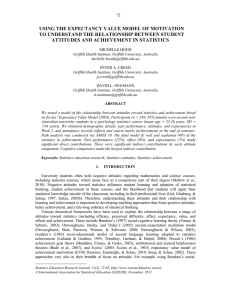slides
advertisement
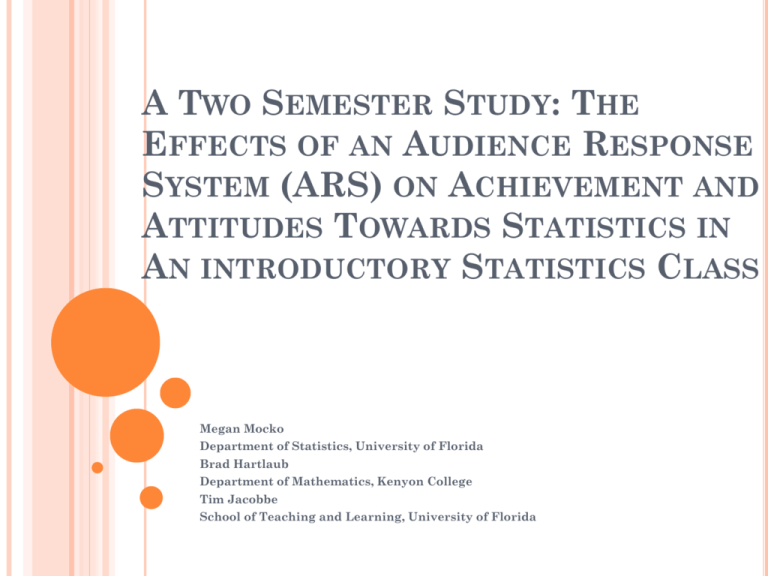
A TWO SEMESTER STUDY: THE EFFECTS OF AN AUDIENCE RESPONSE SYSTEM (ARS) ON ACHIEVEMENT AND ATTITUDES TOWARDS STATISTICS IN AN INTRODUCTORY STATISTICS CLASS Megan Mocko Department of Statistics, University of Florida Brad Hartlaub Department of Mathematics, Kenyon College Tim Jacobbe School of Teaching and Learning, University of Florida PURPOSE OF STUDY Does using an audience response system for classroom participation . . . Improve students attitudes about statistics? Improve students understanding of statistics and thus improve their grades? Outline What is an audience response system? Background Design of the study Assessments used Discussion of the findings Ideas for future research WHAT IS AN AUDIENCE RESPONSE SYSTEM(ARS)? Handheld device similar to a TV remote Teacher asks a question with multiple choice answers and the students respond by pressing the appropriate answer. The students answer is received and recorded. The class’s results can be viewed, but individual student responses are anonymous. Manufacturers: H~ITT, TurningPoint, I-Clicker, etc. DESIGN OF THE STUDY Year One (2009) Year Two (2010) Clicker Session: (n=17) • Answered 1 to 3 nonrelated questions per class period with remotes • Allowed to discuss questions with neighbors. Clicker Session: (n=10) • Answered 3 related questions per class period with remotes • Allowed to discuss questions with neighbors EXCEPT for the last question. Non-Clicker Session: (n=10) • Answered 1 to 3 nonrelated questions per class period as a class • Allowed to discuss questions with neighbors. Non-Clicker Session: (n=20) • Answered 3 nonrelated questions per class period as a class • Allowed to discuss questions with neighbors. Questions and answers were posted online for both sections to access after the class was over. BACKGROUND Garfield, Hogg, Schau and Whittinghill (2002 suggest that the “desired outcomes of an introductory course include the following categories: learning (student’s understanding, reasoning, thinking), persistence (leading students to use their statistical knowledge and skills after they leave the course) and attitudes and beliefs (about the value and importance of statistics and about themselves as learners and users of statistics” (Garfield, Hogg, Schau, Wittinghall, 2002, para. 8). Breaking up the lectures into more easily digestible bites increases student learning (Middendorf & Kalish, 1996). ASSESSMENTS Course Assessments 12 homework assignments 12 quizzes 7 ( 13 during second year) labs (“hands on computer activities”) 4 tests Survey of Attitudes Towards Statistics - 36+ by Candace Schau Affect – “positive and negative feelings concerning statistics” Cognitive Competence – “attitudes about intellectual knowledge and skills applied to statistics” Value – “attitudes about the usefulness, relevance, and worth of statistics in personal and professional life” Difficulty – “Attitudes about the difficulty of statistics as a subject” Interest – “Students self-reported level of individual interest in statistics” Effort – “Amount of work students say that they expend to learn statistics” STUDENTS COMMENTS “… the overall concept made me want to think about the answer and try to solve it without giving up.” “The remotes made you cover information that would be on the exams; caused you to think quick and help you practice on a daily basis.” “A lot because it’s either you know it or you don’t and that helps you to be more confident in your answers, ” “Influenced a lot, it made me think on my toes and helped me to recall information in my head. It also helped reinforce what I learned the previous day.” “It made me pay more attention therefore I participated more. I think that they are good because the teacher can then explain the problem if nobody understood it.” “I would not have come to class if we didn’t have remotes.” “I feel like the remote helped only a little.” ANALYSIS AND CONCLUSIONS Analysis The regression equation is GradeInClass = 1606 - 3.60 ClickerIndicator - 0.76 Year_Indicator + 12.1 GenderIndicator - 4.45 Affect + 3.38 Cogn.Comp - 2.60 Difficulty - 0.31 Interest - 0.32 Effort Predictor Constant ClickerIndicator Year_Indicator GenderIndicator Affect Cogn.Comp Difficulty Interest Effort Coef 1606 -3.599 -0.759 12.104 -4.450 3.376 -2.600 -0.307 -0.324 SE Coef 7058 3.391 3.512 3.781 1.959 2.888 2.383 1.560 1.282 T 0.23 -1.06 -0.22 3.20 -2.27 1.17 -1.09 -0.20 -0.25 P 0.821 0.295 0.830 0.003 0.029 0.250 0.282 0.845 0.802 Conclusions: No statistically significant evidence that remote use or year affected grade at the end of the year. Limitations: Students were not randomly put into sections each year and there are a few outliers, so residuals do not have as good a normal distribution as we would like. I still believe that the remotes can be an effective tool to help students become engaged with the material when used in the right way. More research should be done to test effective use of the remotes in the classroom. REFERENCES Garfield, J., Hogg, B. Schau, C. & Whittinghall, D. (2002). First Courses in Statistical Science: The Status of Educational Reform Efforts. Journal of Statistics Education [online], 10(2). Retrieved December 30, 2009 from http://www.amstat.org/publications/jse/v10n2/garfield. html Middendorf, J. & Kalish, A. (1996). The “Change Up” in Lectures. National Teaching and Learning Forum, 5(2). Retrieved January 10, 2010 from http://www.indiana.edu/~teaching/ allabout/pubs/changeups.shtml Schau, C., Stevens J., Dauphinee, T., and Del Vecchio, A. (1995). The development and validation of the survey of attitudes toward statistics. Educational and Psychological Measurement, 55, 868-875. Schau, C. (2003). Students’ attitudes: The “other” important outcome in statistics education. Retrieved December 30, 2009 from http://evaluationandstatistics.com/JSM2003.pdf. Schau, C. (2003). Survey of Attitudes Toward Statistics +36. Retrieved December 30, 2009 from http://www.evaluationandstatistics.com/sitebuildercontent/sitebuilderfiles/bizwaters ats36monkey.pdf.






